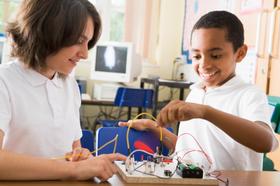Top Rankings
Irvington Community School District ranks among the top 20% of public school district in Indiana for:
Category
Attribute
Diversity
Most diverse schools (Top 1%)
For the 2025 school year, there are 3 public elementary schools serving 939 students in Irvington Community School District. This district's average elementary testing ranking is 4/10, which is in the bottom 50% of public elementary schools in Indiana.
Public Elementary Schools in Irvington Community School District have an average math proficiency score of 25% (versus the Indiana public elementary school average of 41%), and reading proficiency score of 39% (versus the 40% statewide average).
Minority enrollment is 43% of the student body (majority Black), which is more than the Indiana public elementary school average of 37% (majority Hispanic and Black).
Overview
This School District
This State (IN)
# Schools
3 Schools
1,434 Schools
# Students
939 Students
662,155 Students
# Teachers
n/a
44,024 Teachers
Student : Teacher Ratio
n/a
n/a
Student By Grade
District Rank
Irvington Community School District, which is ranked within the bottom 50% of all 389 school districts in Indiana (based off of combined math and reading proficiency testing data) for the 2022-2023 school year.
The school district's graduation rate of 67% has decreased from 85-89% over five school years.
Overall District Rank
#244 out of 395 school districts
(Bottom 50%)
(Bottom 50%)
Math Test Scores (% Proficient)
25%
39%
Reading/Language Arts Test Scores (% Proficient)
39%
41%
Science Test Scores (% Proficient)
22%
34%
Graduation Rate
67%
88%
Students by Ethnicity:
Diversity Score
0.61
0.57
% American Indian
n/a
n/a
% Asian
1%
3%
% Hispanic
15%
14%
% Black
18%
14%
% White
57%
63%
% Hawaiian
n/a
n/a
% Two or more races
9%
6%
All Ethnic Groups
District Revenue and Spending
The revenue/student of $10,478 in this school district is less than the state median of $13,184. The school district revenue/student has grown by 10% over four school years.
The school district's spending/student of $11,346 is less than the state median of $12,815. The school district spending/student has grown by 10% over four school years.
Total Revenue
$10 MM
$13,615 MM
Spending
$11 MM
$13,234 MM
Revenue / Student
$10,478
$13,184
Spending / Student
$11,346
$12,815
Best Irvington Community School District Public Elementary Schools (2025)
School
(Math and Reading Proficiency)
(Math and Reading Proficiency)
Location
Grades
Students
Rank: #11.
Irvington Preparatory Academy
Charter School
(Math: 25% | Reading: 39%)
Rank:
Rank:
4/
Bottom 50%10
5751 E University Ave
Indianapolis, IN 46219
(317) 357-5359
Indianapolis, IN 46219
(317) 357-5359
Grades: K-12
| 328 students
Rank: n/an/a
Irvington Community Elementary School
Charter School
6705 E. Julian Ave
Indianapolis, IN 46219
(317) 357-3770
Indianapolis, IN 46219
(317) 357-3770
Grades: PK-5
| 397 students
Rank: n/an/a
Irvington Community Middle School
Charter School
6040 E. Pleasant Run Parkway
Indianapolis, IN 46219
(317) 357-1170
Indianapolis, IN 46219
(317) 357-1170
Grades: 6-8
| 214 students
Recent Articles

The 15 Biggest Failures of the American Public Education System
The world is in a constant state of change and those who fail to adjust fall behind. Unfortunately, the American public education system has not kept up with the times and is currently facing a number of serious problems. Keep reading to learn about the biggest failures affecting the modern U.S. public education system as well as some of the trends that could spark change.

Florida Governor Calls for More Funding for State鈥檚 Public School System
Florida Governor Rick Scott has introduced a state budget for next year that pumps one billion more dollars into the public school system. We鈥檒l look at his reasons for the increase and the responses to the proposal.

Can Your Child鈥檚 School Meet the National Standards?
The article discusses the challenges public schools face in meeting national educational standards. It examines current performance trends, identifies key issues affecting student achievement, and explores potential solutions for improving academic outcomes across U.S. public schools.





